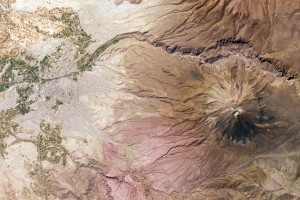WEDNESDAY, 31 OCTOBER 2012
Magma is a mixture of molten rock, found beneath the Earth’s surface and which often collects in chambers to feed a volcano. Magma can also build up in so-called ‘hotspots’ and intrude into overlying rocks, causing a build-up of pressure. One of the largest active magma bodies is found at the Altiplano-Puna plateau, at the border of Argentina, Bolivia and Chile. Scientists from the Scripps Institute of Oceanography have found that the magma here is pushing up the Earth’s crust across an area 100km wide, while the surrounding area sinks, leading to a geological oddity that has the shape of the Mexican hat, the Sombrero.Using a combination of satellite data and computer modelling, Yuri Fialko and Jill Pearse found that this ‘sombrero uplift’ is happening at a rate of approximately 1cm per year (roughly the rate fingernails grow) and that it is likely due to a blob of magma, called a diapir, forming on top of the Altiplano-Puna magma body. This pushes up and deforms the Earth’s crust. Despite the subtle motion, its persistence is unusual as most other magmatic systems tend to go through periods of inflation and deflation. However there is no immediate danger of a volcanic eruption and computer models suggest that the surface uplift will gradually slow down.
Interestingly, super volcanoes are thought to arise in a similar manner. These produce eruptions thousands of times more powerful than most volcanoes and can cause changes to both the local and global climate. Although no super volcanoes have erupted in human history, they are thought to be caused when magma rises into the Earth’s crust, leading to a build up of pressure which eventually can no longer be contained. Studying the sombrero uplift may therefore provide insights into the birth of super volcanoes.
DOI: 10.1126/science.1226358
Written by Laura Pearce

